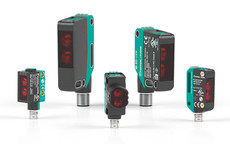This form of sensing is commonly referred to as the proximity mode. Light from the emitter strikes the target which causes it to become diffused at arbitrary angles. Some light returns directly to the receiver and the target is detected. Factors pertaining to the sensing range are color, size and finish of the target. The actual sensing range for each model is based upon a “white test card.” The white card has a 90% reflectivity factor and is considered a “standard target.” Darker colored or matte finished targets provide less reflectivity; therefore the sensitivity must be increased or the entire sensor must be positioned closer to the target. When this situation occurs, care should be taken so that a brighter target in the background is not mistaken as the actual target.
There are various type of diffused mode sensing:
- Diffused with background suppression: Diffused sensors with background suppression sensors have a defined sensing range for any object regardless of color, reflectivity or finish. They are able to detect dark objects placed directly on shiny backgrounds and can be easily installed and adjusted
- Diffused with foreground suppression: Diffused sensors with foreground suppression sensors define a “dead-band” from the sensor’s optical window. Objects falling inside this minimum sensing distance are ignored
- Diffused with background evaluation: Diffused sensors with background evaluation only evaluate the light reflected by the background (i.e. the floor). If the sensor is not able to see the background, the output will change state. This is useful in applications with odd shaped targets where the user can not ensure light directed at the target will be reflected back to the sensors
The following application specific sensors are also based on the principle of diffuse mode sensing:
- Color mark/ print mark or contrast sensors
- Luminescence sensors
- Color sensors








 +27 87985 0797
+27 87985 0797